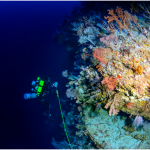Source: New York Times
Author: JoAnna Klein
Between the ocean’s bright blue surface and its blackest depths — 660 to 3,300 feet below — is a mysterious, dark span of water. Welcome to the twilight zone.
Recent evidence suggests there are more animals here by weight than in all of the world’s fisheries combined. But who lives here, and in what quantities?
Continue reading Visitors From the Ocean’s Twilight Zone






